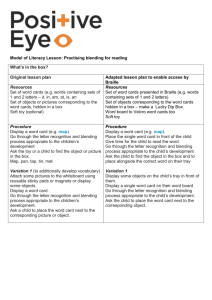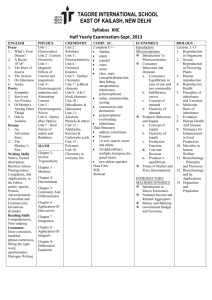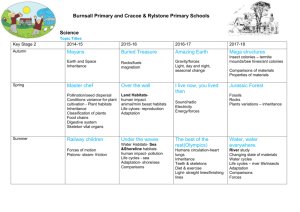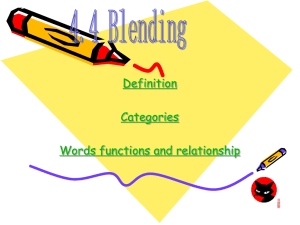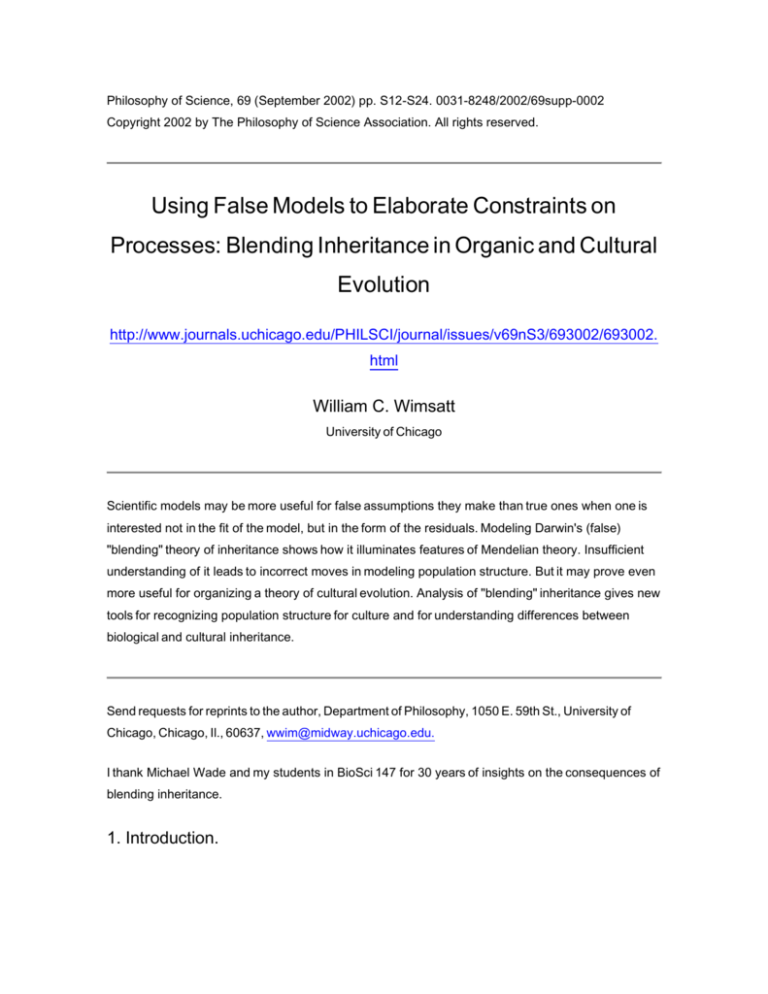
Philosophy of Science, 69 (September 2002) pp. S12-S24. 0031-8248/2002/69supp-0002
Copyright 2002 by The Philosophy of Science Association. All rights reserved.
Using False Models to Elaborate Constraints on
Processes: Blending Inheritance in Organic and Cultural
Evolution
http://www.journals.uchicago.edu/PHILSCI/journal/issues/v69nS3/693002/693002.
html
William C. Wimsatt
University of Chicago
Scientific models may be more useful for false assumptions they make than true ones when one is
interested not in the fit of the model, but in the form of the residuals. Modeling Darwin's (false)
"blending" theory of inheritance shows how it illuminates features of Mendelian theory. Insufficient
understanding of it leads to incorrect moves in modeling population structure. But it may prove even
more useful for organizing a theory of cultural evolution. Analysis of "blending" inheritance gives new
tools for recognizing population structure for culture and for understanding differences between
biological and cultural inheritance.
Send requests for reprints to the author, Department of Philosophy, 1050 E. 59th St., University of
Chicago, Chicago, Il., 60637, wwim@midway.uchicago.edu.
I thank Michael Wade and my students in BioSci 147 for 30 years of insights on the consequences of
blending inheritance.
1. Introduction.
I have taught blending inheritance to students in courses on genetics and
evolution, and they have simulated its consequences
on programmable
calculators (from 1976) and computers (since the mid 1980's). With inheritance of
acquired characters, (the other major embarrassment of Darwin's theory
Olby
1966, Wallace 1968)1 it is swept under the rug in Whiggish presentations of
evolutionary genetics. But blending inheritance is a powerful tool for understanding
key consequences of Mendelian genetics and guiding new theory construction for
evolutionary processes with non-Mendelian inheritance. I focus on the latter here:
you can simulate and explore the former with software (Schank and Wimsatt 1993)
described in Wimsatt and Schank 1993.
Blending inheritance was commonly accepted by hybridists of the eighteenth
and nineteenth centuries. Darwin was no exception. It apparently worked well for
most hybrid traits.2 Exceptions which retrospectively suggested Mendelian
segregation seemed just quirky. So Fleeming Jenkin's crisply engineered critiques
of blending in his searching review of the fourth edition of the Origin in 1867 was a
bombshell that left lasting impressions. R. A. Fisher began his 1930 classic, The
Genetical Theory of Natural Selection, with a discussion derived from Jenkin's
analysis. To Fisher, Jenkin's arguments showed that Mendel was needed to make
the world safe for Darwinism: blending inheritance (with panmixia) in large
populations would halve the variance in each generation. Evolutionary processes
feeding on that variance must (by Fisher's own "fundamental theorem of natural
selection") either grind to a halt or produce or conserve variance by other means.
Since the equilibrium variance in the population would be only twice that produced
per generation, either new variance is produced at a rapid rate or evolution
proceeds slowly indeed (Fisher 1930; Wallace 1968; Wimsatt 1980, 1981). This
problem is blamed for Darwin's increasing dalliance with the inheritance of acquired
characteristics, as a source of new variation. Thankfully, Mendelism appeared to do
away with blending inheritance. Or did it?
Reading Fleeming Jenkin for class, I noticed in 1975 that the "migrant pool"
assumption that colleague Mike Wade criticized in models of group selection was a
kind of blending inheritance at the group level.3 All groups as "parents" contributing
migrants to a pool from which all "offspring" groups would be drawn led to even
faster blending for group inheritance than Fisher showed for bi-parental organisms
(Wade 1978; Wimsatt 1980), and made it far too easy to dismiss group selection. It
ignored local population structure implied by having populations found new groups
near them. In 1981 I generalized this constraint (roughly: do not blend beyond
necessity) to identify "segregation analogues" retarding loss of variance at higher
levels of population structure. (In an open system with new variance constantly
produced and consumed, a lowered rate of loss proportionately increases
equilibrium variance. See equations in Wimsatt 1980, 1981 derived by Wade and
myself.) These constructions suggested that (and why) current theory still tends to
underestimate how important population structure is for evolution.
Informal discussions of cultural inheritance sometimes treat it as "blending."4 It
cannot be, at least not commonly: rich complex and diverse cultural variations are
transmitted in highly conserved fashion across generations in ways inconsistent
with this claim. How? I first illustrate the effects of blending inheritance in an
idealized system. This "false" model then allows us to explore the nature of the
constraints on uncontrolled mixing for cultural inheritance and evolution.
2. Basic Description of the Model.
Imagine a physical analogue for a model population with "blending"
inheritance an indefinitely large population of water-filled beakers. The population
has beakers of either clear (W) or red-colored (R) water in relative frequencies p
and q (q = 1 - p). Mating involves thorough mixing of water from pairs of beakers
chosen at random and redistributed equally between them, producing offspring for
the next generation. This continues until all beakers are mated. The population of
offspring beakers then becomes the parent population, and the process is
repeated. There is no mortality, differential reproduction, or change in population
size, hence no selection, so all changes are due just to the modes of inheritance
and mating rule. With pairs of beakers, mating is biparental. Since any two beakers
can mate, sex doesn't matter, or the two sexes are equally frequent. With random
choice of beakers, "panmixia" is assumed, so there is no assortative mating or
population structure. Then the frequency of any type of mating is simply the product
of the frequencies of the two types involved.5 To mark blending or Mendelian
systems below, I will use R and W for blending factors, and A and B for Mendelian
ones.
3. A Binomial Distribution Model of Blending Inheritance.
Consider the binomial expansion for (p + q)m:
Cancellations in exponents, numerators, and denominators reduce the penultimate
term to mp1qm-1, symmetric with the second term
save for interchanged exponents
for p and q. So also for other symmetrically located terms.
This expansion has:
m + 1 terms.
The coefficients of p and q in these terms ("binomial coefficients," denoted by C(m,
0), C(m, 1), ... , C(m, k), ... , C(m, m). Assuming m k, C(m, k) is the number of
different collections of k objects one can get from m objects (drawing k at a time
with replacement before the next draw).6
For modeling blending inheritance, suppose that p + q = 1, so (p + q)m = 1m = 1.
Let p be the proportion of red beakers and q be the proportion of white beakers
in the original population. Since any beaker is either red or white initially
then p +
q = 1.
Claim: If we start with pure red and pure white beakers in any proportion, the
behavior of this population with blending inheritance is given by the
binomial distribution for (p + q)m where m = 2G, where G is the generation
number (0 at the start).7
The following correspondences then hold between the binomial and the
imagined case of blending inheritance:
There are 2G + 1 types in the Gth generation.
The powers of p and q give relative proportions of R and W in the type
corresponding to that term. Thus the fourth term in generation 3 contains p5q3,
corresponding to type R5W3.
Evaluation of a term gives the frequency of its type. Thus, for p = q = 0.5, the fourth
term in the expansion for G = 3 has the form C(8, 3)p5q3, and gives the frequency
of type R5W3 (proportions .625R and .375W), which is 56[1/28] = 0.2187.
Types in the G-th generation are spaced at intervals of 1/ 2G of the total in
composition.
The sum of all proportions of all types for any generation is 1.
Figure 1 depicts the second generation of a blending inheritance process. (The
first generation is just like that for Mendelian inheritance, even producing HardyWeinberg proportions of types!) We return to this surprising fact below.
Figure 1.
Blending Inheritance in a Panmictic Population: second generation
from initial frequencies of p and q of pure types B and Cin starting population.
These produce types BB, BC, and CC in the first generation, which do not
segregate but breed true, unlike the corresponding Mendelian types.
In successive generations of a blending process, new types appear between
neighboring types. The first generation produces 3 types, RR, RW, and WW as
input types for matings in the second generation. The 3 × 3 square (a "Punnett
square" for blending inheritance) has the 3 possible types for each parent in their
respective frequencies of p2, 2pq, and q2, yielding 5 offspring types. (In the Punnett
square of offspring, these are the squares in the diagonal rising to the right, and its
4 "parallels," two on each side and each having its characteristic powers of p and
q.) Each identically hued square in a parallel gives one exclusive way in which that
proportion of R and W can arise from the types of the preceding generation. These
exhaust all possibilities: adding their frequencies gives proportions in the next
generation, which breeds to form a 5 × 5 array with 9 diagonals, etc. The Punnett
squares define the combinatorial possibility space for genotypes assembled from
those input arrays of parental contributions.
The binomial distribution for a generation thus contains all necessary
information on the number, composition, and relative frequencies of types produced
in that generation from a blending inheritance process with initial proportions p and
q of R and W beakers. In successive generations you square the distribution of
types produced in the last generation. Starting with a distribution (p + q) of types in
the 0th generation, we get (p + q)2 types in the 1st generation, ((p + q)2)2 = (p + q)4
types in the 2nd generation, (((p + q)2)2)2 = (p + q)8 types in the 3rd generation, and
so on. This is why m in the G-th generation = 2G.
Unlike Mendelian inheritance, blending inheritance is absolutely "true breeding":
like parents produce only like offspring. Mendelian inheritance does this if parents
are identical homozygotes, but blending inheritance is broader still: if parents differ,
(not covered by Mendelian true-breeding) blending produces a new shade which is
the average of parental shades. So the number of types increased as 2G + 1,
roughly doubling each generation.
The corresponding Mendelian process with frequencies p and q of genotypes
AA and BB mating at random would produce proportions p2AA + 2pqAB + q2BB of
the 2 original (homozygous) genotypes, and a new heterozygous genotype, AB.
Each genotype passes on only one of its two factors, each with equal probability.
This produces a 2 × 2 table for the combination of factors the outcomes of matings
between any two genotypes. The array of these tables multiplied by the frequencies
of those matings describes the population process.
Mendelian segregation is so named for the fact that breeding two identical
(single-factor) heterozygotes, AB × AB, reproduces them (on average) only half of
the time, and AA and BB in equal frequency the rest, giving the classic Mendelian
ratio of expectations, 1AA:2AB:1BB. This cross increases the number of types
represented from 1 to 3
increasing the variance in the population. At equilibrium,
these increases are exactly balanced by crosses of AA and BB to produce AB's. So
the proportions of homozygotes and heterozygotes are preserved generation after
generation, as p2AA + 2pqAB + q2BB. Thus, so is the variance one reason why
evolutionists like the Hardy-Weinberg equilibrium principle. Variance conserved is
variance usable by selection.
What of the other crosses? AA × AA and BB × BB will obviously produce nothing
new on either system. With Mendelian inheritance the 2 × 2 tables for an AA × AB,
or AB × BB cross shows no new types or changed proportions either, so they do not
disturb the equilibrium. But blending inheritance would produce new types in these
last crosses: all offspring of RR × RW are identically R3W1, and offspring of RW ×
WW are R1W3. There can't be an equilibrium of types because new mixed types
with successively finer gradations between them are constantly being created.
There is an asymptotic equilibrium in the limit: variance goes to zero as the
distribution gets peakier about the mean, but because evolution requires variance
for selection to work, this equilibrium would not delight any evolutionist. Figure 2
depicts types and their relative frequencies in a blending process from generations
1 5 with starting frequencies of p = .75, q = .25. We see a doubling of types (3, 5, 9,
17, 33,...), with decreasing frequencies of each (they must sum to 1), and the
asymptotic clustering of the distribution closer and closer to the mean.
Figure 2.
Frequency of types under blending inheritance in generations
1 5. Generation 1 in black, with each later generation adding intermediate
types in lighter shades. Frequencies of each type declines, but summed
contribution in intervals about mean (of q = .25) increases monotonically,
producing successively "clumpier" distributions with halved variances. Output
from program in Schank and Wimsatt 1993.
4. Blending and Population Structure as Exo-genetics.
So Mendelian inheritance conserves variance and blending inheritance
dissipates it? Not quite so simple! Both blending and Mendelian inheritance
produced the same distribution of types in the first generation, with reduced
variance. Why no difference here? In any population with two or more8 different
Mendelian homozygotic types, the variance is halved in the first generation as we
go to Hardy-Weinberg proportions through the production of heterozygotes. In this
maximally mixed state, every genotype occurs with a frequency equal to the
product of frequencies of its constituents. It is an equilibrium because it is an
entropic maximum (Wimsatt 1981). This maximally mixed state is an entropic
minimum of variance for the constraints determining the architecture of the
genome. This feature of Mendelian blending is also recognized in Wahlund' s
Principle: combining differentiated sub-populations into a single large panmictic
population will always result in a loss of variance.
Now things look a little different! Particulate genes prevent the infinite divisibility
of qualities suggested by blending inheritance, thus leading to an equilibrium
variance greater than zero. This is internal or endo-genetic non-blending, and all
that traditional discussions recognize. But there is also mixing external to the
organism: With panmixia, or population-wide random mating, any organism's
chance of mating with any other genotype is proportional to its frequency in the
population. This is the strongest possible form of blending of population or exo-
genetic structure.9 A total denial of effects of group structure at any level on
probability of mating, it "idealizes" groups out of existence. This is why the "migrant
pool assumption" is so detrimental to group selection. Models using it had
(surprisingly?) succeeded in showing that under conditions with no groups, group
selection is not a significant evolutionary force.
The single-locus case with panmixia yielding H-W equilibrium in one generation
is the fastest possible loss of variance through mixing processes. (Most structures
yield asymptotic approaches to H-W equilibrium.) It thus can provide a reference
standard for all other cases. Any structural factor causing a slower loss of variance
is a "segregation analogue" for those effects. In equations for the rate of approach
to Hardy-Weinberg equilibrium, one can identify factors retarding the rate below this
maximum (Wimsatt 1981, p. 163, table 3). Asymptotic approach to multi-locus H-W
equilibrium is attributable to other endo-genetic segregation analogues, in particular
linkage (commmonly recognized), and (less commonly recognized) diploid gametic
organization (Wimsatt 1981, 2002). Sex-linkage and overlapping generations also
slow the approach to H-W equilibrium. That's four factors acting as "segregation
analogues" already in classical theory, kinds of structure which slow mixing.
Wade and I derived an equation for rate of loss of variance in group selection
that exhibits two further exo-genetic structural parameters (Wimsatt 1981). These
are the ratio of 1-generation migration distance to species range and to the mean
distance between groups. (The first is a "mean-free-path" like parameter of
diffusion, and the second is a measure of how many parental groups might be
involved in parenting each new group.) Greater values of either yield more extreme
exo-genetic blending.
We commonly regard endo-genetic factors as parts of genetic architecture. But
exo-genetic factors, commonly lumped under "population structure," are equally so:
they both affect genotype frequencies produced by matings and they are equally
efficacious for outcomes in population genetic models. Population structure is not
an add-on. Panmixia is not a benign assumption. Assuming it when absent is as
serious an error as assuming that endo-genetic structure is blending when it is
particulate. And we are constantly reminded how serious that is! (Fisher 1930).
5. Blending and Cultural Inheritance.
There are two main ways Darwin could have avoided the consequences of
blending inheritance: selection and assortative mating. Jenkin (1867) considered
both but incorrectly dismissed them as implausible. They can be effective for both
biological and cultural evolution. Selection against hybrids keeps distinct lineages
pure (or purer if selection is not absolute). It secures genetic isolation of distinct
species and can select for behavioral isolation in incipient species. It works also for
cultural evolution if those who partially assimilate are discriminated against by
parent populations or otherwise disadvantaged. Such selection can be mediated in
many ways by diverse cultural mechanisms. It is worth further discussion
elsewhere.
I focus here on exploiting parallels with "segregation analogues" to elaborate a
cultural exo-genetics. Jenkin noted correctly that strict mating segregation
like with like
mating
prevents blending, but thought it improbable or rare not too
observant of his own society!10 Above I used the Hardy-Weinberg equation as a
reference standard for detecting structure in the hereditary system by looking for
factors which retarded the rate of loss of variance below that defined for 1-locus
panmixia. Analysis of blending inheritance draws attention to production and
dissipation of variance. How do cultures resist blending homogeneity? We can talk
of mixing of populations, but blending of traits is more problematic: the absence or
problematic character of a genotype-phenotype distinction for culture, and the many
"non-quantitative" cultural traits for which we don't know what "blending" means.
Still other problems are raised by the fact that cultural heredity is a multi-channel
system with complex modes of inter-channel modulation, whereas biological
inheritance is treated as a single channel (and Weismannian, permitting no direct
modulation other than through selection.)11
Cultural inheritance is more plausibly a multi-channel system, with different
characteristics for each channel and complex interactions and potential cross-talk
between them. How do we handle different languages? Must language, picture,
dance, and other lineages of practice for transmission of culture be commensurate,
and if so, how? It is not clear how one defines blending or its absence for such a
system or any system without quantitative characters. But we could still recognize
loss of variation and use information-theoretic measures for diversity (Shannon and
Weaver 1949). But before we worry about this, it makes sense to delineate the
important structures special to culture which further constrain inheritance patterns,
preventing mixing or blending, however defined, and allowing for richer and more
multi-dimensional cultural differentiation. Two of the most striking features (Wimsatt
1999) of our cultural inheritance systems are:
1. Unlike biological inheritance, our cultural genotype is not acquired in a bolus at the
beginning, but over time as we develop, learn, and age. This both makes multiple
hereditary channels more likely and significant modulations of our access inevitable,
as we age, change capabilities, and roles. Modulations of access provide potential
segregation analogues, and multiple hereditary channels can interact epistatically
and asymmetrically, producing other interactions which can provide qualitatively
new (and non-blending) complexities.
2. Virtually all complex abilities and cultural structures show strong sequential
dependencies in their acquisition. You must walk before you can dance because the
latter is a modulation of the former, and you must learn arithmetic, algebra, and
geometry in order to learn the calculus, because the latter requires skills, procedures,
and concepts derived from all of the former. (This rich structure of dependencies is
nowhere utilized by "meme" theories, which is one of their gravest shortcomings.)
These dependencies have consequences. Thus, (1) cultural elements acquired
earlier may actively bias reception of later ones, providing intra-individual sources of
selection. Evolutionists and creationists not only learn and believe different things,
but acquire different filters affecting passive and active knowledge acquisition,
normative behavior, and methodological criteria for evaluation. (2) For acquisition of
complex and sequentially dependent knowledge or skills, adjustments in education,
social roles, production, and management responsibilities produce life trajectories
with many commonalities across cultures and across roles within cultures. (3)
These sequential dependencies significantly affect movement of individuals,
knowledge, and skills within the culture, and produce differentiated "micro-cultures"
of knowledge and practice which recruit and maintain themselves and interact with
other micro-cultures (institutions). (4) These micro-cultures in turn provide important
structures facilitating the acqusition of complex sequentially dependent skills. (5)
Different selectivities for different aspects of culture, together with our increasing
interactions with different reference groups in our different roles (condo meetings,
classes, "soccer-parents," department meetings, computer OS users, professional
meetings, interest-group mailing lists, etc.) produces a richly structured overlapping
fabric of "weak ties" cross-cutting these institutions, and usable for other purposes.
All of these produce structures that can generate or maintain boundaries or
channels of communication within culture on a number of size scales.
In the simplest population genetic models, migration into a new population leads
naturally to mating. This focuses attention on the consequences of spatial structure
on mating processes, but is far too simple. All kinds of other things connected with
social standing affect probability of mating for primates and indeed for all sorts of
animals. Spatial structuring affects mixing of traits both for culture and for biology,
but for culture a host of other culturally structuring properties modulate transmission
and exchange of cultural elements. This points to an important difference between
biological and cultural inheritance: For biology, if you mate for one property, you
mate for them all. An adequate theory of cultural change must deal with the
different overlapping connectivities induced by our different connections and our
different filters. Cultural promiscuities operate in a much higher-dimensional space.
If biological reproduction were like cultural congress, it would be kinky indeed.
6. Conclusion: False Models as Means to Truer Theories.
Scientific models are often as useful for the false assumptions they make as for
what truths they might embody. One often designs a false model deliberately for
use as a template to compare with data when one is interested not in how well it fits
the data, but in the form of the residuals where it does not fit, how and why
(Wimsatt 1987). This can be a powerful tool in the construction of new theory.
Darwin's "blending" model of inheritance is profoundly false, but it illuminates
strengths and characteristics of the accepted Mendelian theory, and an insufficient
understanding of it has lead to incorrect moves (or "missed warnings") in newer
theoretical developments: the treatment of group selection and population structure.
But it may prove even more useful for organizing a theory of cultural evolution
(Wimsatt 1999, 2001). There is no internal "memetics" for culture, so questions of
endo-genetic blending do not arise for cultural traits, but exo-genetics or population
structure, important but underappreciated in the biological case, remain as a critical
element for any evolutionary theory. For culture, exo-genetics operates in a space
of many more dimensions for rich interaction
dimensions yet to be exploited for
theory. Generalization of some of the concerns from Darwin's incorrect theory have
provided useful tools and templates to use in starting to think about how culture is
generated and structured within the context of an evolutionary theory of cultural
change.
References
Boyd, Robert, and Peter Richerson (1985), Culture and the Evolutionary Process.
Chicago: University of Chicago Press.
Cavalli-Sforza, Luigi, and Marcus Feldman (1981), Cultural Transmission and
Evolution: A Quantitative Approach. Princeton: Princeton University Press. First
citation in article
Falconer, D. S. (1960), An Introduction to Quantitative Genetics. New York:
Ronald Press. First citation in article
Fisher, Ronald. A. (1930), The Genetical Theory of Natural Selection. Oxford:
Clarendon Press. First citation in article
Hartl, Daniel (1988), A Primer of Population Genetics, 2nd ed. Stamford, Conn.:
Sinauer. First citation in article
Jenkin, Fleeming. (1867), Review of The Origin of Species, by Charles Darwin. The
North British Review, (June), 46: 277 318. Reprinted in David. L. Hull (ed.),
Darwin and His Critics, Cambridge: Harvard University Press, 302 350. First
citation in article
Nettle, Daniel (1999), Linguistic Diversity. Oxford: Oxford University Press. First
citation in article
Orr, Daniel. (1996), Review of Darwin' s Dangerous Idea, by Daniel Dennett.
Evolution 50: 467 472. First citation in article
Oyama, Susan, Paul Griffiths, and Russell Gray (eds.) (2001), Cycles of
Contingency: Developmental Systems and Evolution. Cambridge, Mass.: MIT Press.
First citation in article
Schank, Jeffrey C., and William C. Wimsatt (1993), ModelBuilding 2.0. Simulation
software for Macintosh for teaching model building and its critical analysis.
BioQUEST library of Strategic Simulations. Academic Press (on CD-ROM). First
citation in article
Shannon, Claude E., and Warren Weaver (1949), The Mathematical Theory of
Communication. Urbana: University of Illinois Press. First citation in article
Wade, Michael (1978), "A Critical Review of the Models of Group Selection",
Quarterly Review of Biology 53: 101 114. First citation in article
Wallace, B. (1968), Topics in Population Genetics. New York: W. W. Norton. First
citation in article
1
Wimsatt, William C. (1980), "Reductionistic Research Strategies and Their Biases
in the Units of Selection Controversy", in T. Nickles (ed.), Scientific DiscoveryVol.II: Case Studies. Dordrecht: Reidel, 213 259. First citation in article
Wimsatt, William C. (1981), "Units of Selection and the Structure of the Multi-level
Genome", in PSA 1980, Vol. 2. Lansing, Mich.: Philosophy of Science Association,
122 183. First citation in article
Wimsatt, William C. (1987), "False Models as Means to Truer Theories", in M.
Nitecki, and A. Hoffman (eds.), Neutral Models in Biology. London: Oxford
University Press, 23 55. First citation in article
Wimsatt, William C. (1999), "Genes, Memes, and Cultural Inheritance", Biology
and Philosophy 14: 279 310. First citation in article
Wimsatt, William C. (2001), "Generative Entrenchment and the Developmental
Systems Approach to Evolutionary Processes", in S. Oyama et. al. (eds.), Cycles of
Contingency: Developmental Systems and Evolution. Cambridge, Mass.: MIT Press,
219 237. First citation in article
Wimsatt, William C. (2002), "Emergence as Non-Aggregativity and the Biases of
Reductionism(s)", in Re-Engineering Philosophy for Limited Beings: Piecewise
Approximations to Reality. Cambridge, Mass.: Harvard University Press,
(forthcoming). First citation in article
Wimsatt, William C., and Jeffrey C. Schank, (1993), Modelling A Primer (or: the
crafty art of making, exploring, extending, transforming, tweaking, bending,
disassembling, questioning, and breaking models). Academic Press (on CD-ROM).
BioQUEST library of strategic simulations. First citation in article
Olby 1966 is the classic historical treatment; Wallace 1968 was once rare as a modern
exploration of the consequences of blending inheritance but recent texts are discussing it again.
2
Even with the post-Mendelian genotype-phenotype distinction which might lead them to look for
one, the subtle differences in later generations distinguishing blending inheritance from a trait of
more than a few loci would have been hard to extract from environmental variance (Falconer 1960).
3
This case of "Those who don't read history are doomed to repeat it" was repeatable: a biologist
colleague using Jenkin in a course soon after went to Wade with the same observation. Biologists
know blending inheritance as bad, but without studying it, think it was banished at all levels by
Mendelism. We will see that it is not.
4
This common impression is hard to document. Nettle (1999, 21 23) recognizes blending as the
"averaging problem" and considers blending models on his way to better ones. Other supposed
sources warn that blending inheritance is problematic (Orr 1996, 470), or model some cultural traits
which might be "continuous" and diffused, like the inheritance of money without primogeniture
unless mating is not assortative by economic class (Cavalli-Sforza and Feldman 1981, 274).
"Blending" may uncritically (and incorrectly) be used as synonymous for "non-Mendelian."
5
For finite populations, the product is the expected rather than actual frequency of the mating
type.
6
For each draw of k objects, one also leaves behind m - k objects. So the only difference
between draws of k objects and m - k objects lies in which are picked up or left behind. So there
must be the same number of combinations for draws of k objects as for draws of m - k objects, or in
general, C(m, k) = C(m, m - k).
7
The binomial generalizes obviously to the multinomial for blending inheritance of an arbitrary
number of initially "pure" types which could combine quantitatively.
8
This principle generalizes for an arbitrary number of alleles and homozygous genotypes. Under
specific conditions (Hartl 1988, 14 lists eight but there are two more), H-W equilibrium is reached in
one generation from all starting points for 1-locus systems.
9
Thanks to Mike Wade for this improved terminology, recognizing analogies we both celebrate.
10
Assortative mating for cultural traits is much easier than for (not so visible) genetic ones! In
general linkage-like and selection-like factors are easily confounded, as was noted by the Morgan
school as early as 1915 when they cautioned that accurate measurements of linkage required
alternative genotypes of equal fitness.
11
This conception is not unproblematic for biology (Oyama et al. 2001), and the implications of an
interactive multi-channel heredity for culture need further exploration (Wimsatt 1999).

